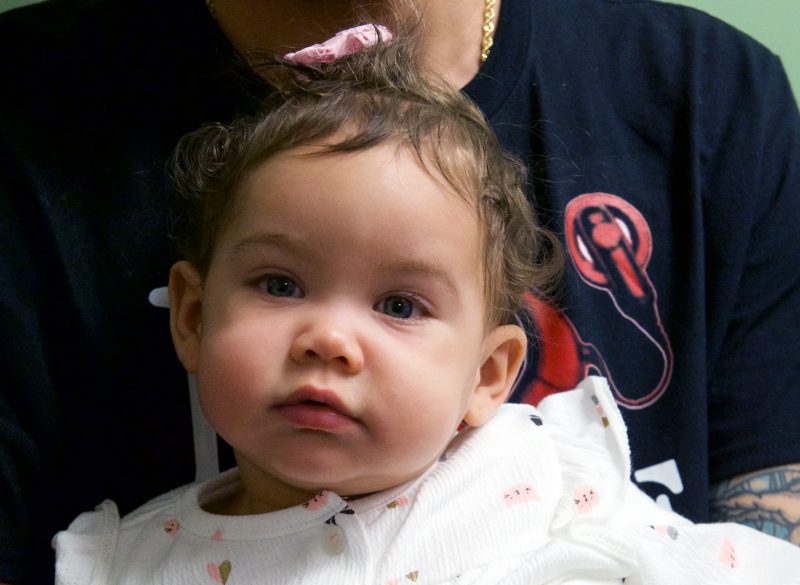
Mia Rodriguez was born with a profound hearing loss in both ears. She essentially was deaf to everyday sounds until bilateral cochlear implants.
Dressed in adorable gold ballet flats and a white ruffled top with matching pants, 9-month-old Mia Rodriguez was observing all the commotion and admiring the cameras and spotlight on her. She locked eyes on her mom, who was calling her by name, because for the first time she heard her mother’s voice. Mia cracked a tiny smile and immediately grabbed ahold of her for comfort.
Today was all about Mia and stopping the silence. She was dressed to celebrate her big day, yet the curious, happy baby had no idea what was in store for her and how her life was about to drastically change for the better.
This was the second hearing test of the day after her bilateral cochlear implant surgery just 2 weeks prior. Mia was born with a profound hearing loss in both ears. She essentially was deaf to everyday sounds. With the ability to only hear extremely loud noises, Mia’s hearing was not strong enough for speech development or thriving in a classroom.
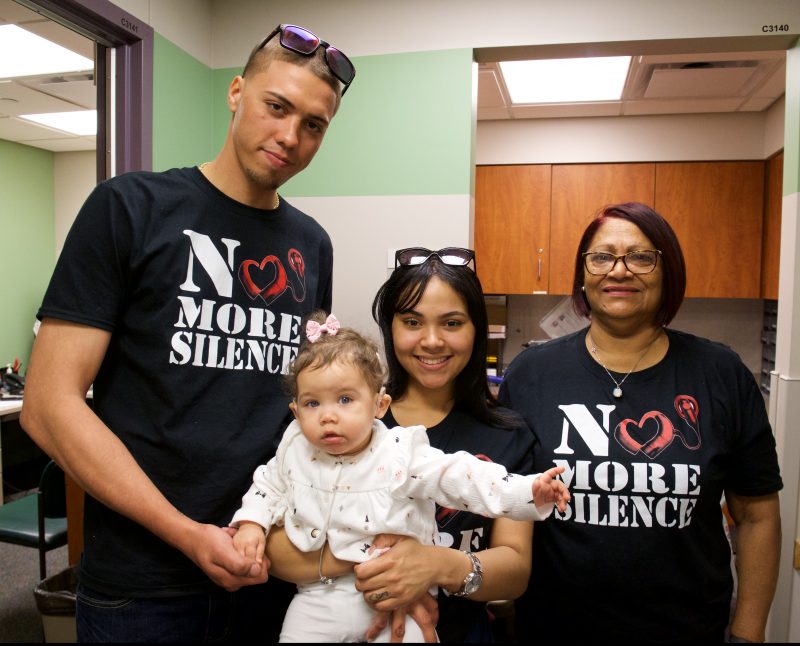
Mia Rodriguez hears her parents and great grandmother’s voices for the first time at 9 months old after cochlear implant surgery at Akron Children’s.
“We’re just so happy and excited,” said her mom, Leeomara Quiles, grinning from ear to ear. “I don’t have words. We thought Mia would be deaf for the rest of her life.”
Smiling, crying, irritability and clinginess are normal reactions for babies hearing sound for the first time, unsure of what’s happening or what it is. Today was Mia’s big day to test the implant, ensuring electrical impulses were reaching her brain, and her reaction to sound.
Audiologist Shelley Duncan and Dr. Anita Jeyakumar were surrounding Mia, while her mother, father, Manuel Rodriguez, and her great grandmother looked on in anticipation to Mia’s reaction, wearing custom T-shirts that read, “No more silence.”
“Mom and dad, make sure you talk to her once it’s turned on,” instructed Dr. Jeyakumar, director of Pediatric Otolaryngology at Akron Children’s. “Many parents are quiet because they’re busy looking for a reaction, but we want Mia to hear your voices first, not ours!”
The audiologist began turning on the sound very low to start and gradually increased it until Mia reacted. The first time around there were tears. Discovering for the first time that things in your environment actually do make sounds after a life of silence can be scary. (See a video of her below!)
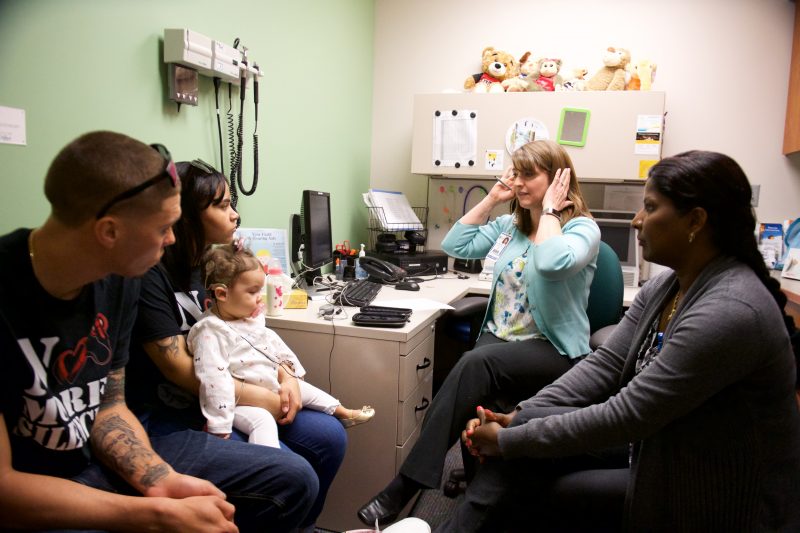
Audiologist Shelley Duncan and Dr. Anita Jeyakumar (at right) explain the activation process.
The goal for the day is to achieve a level of sound that Mia is aware of and comfortable with. At home, her parents are to continue to increase the sound level every few days until Mia reaches a sound audible enough to thrive in everyday surroundings.
Living without hearing, Mia now has to learn what seems to come natural for most. In the next few months, the goal for Mia is to understand that everyday objects actually do make sounds and what they are, learn her own name and speak her first words.
“We expect Mia to increase babbling and turn to sounds consistently in the next few months,” said Dr. Jeyakumar. “A normal hearing child usually says her first word about 1 year of age. We expect Mia to be close to that target.”
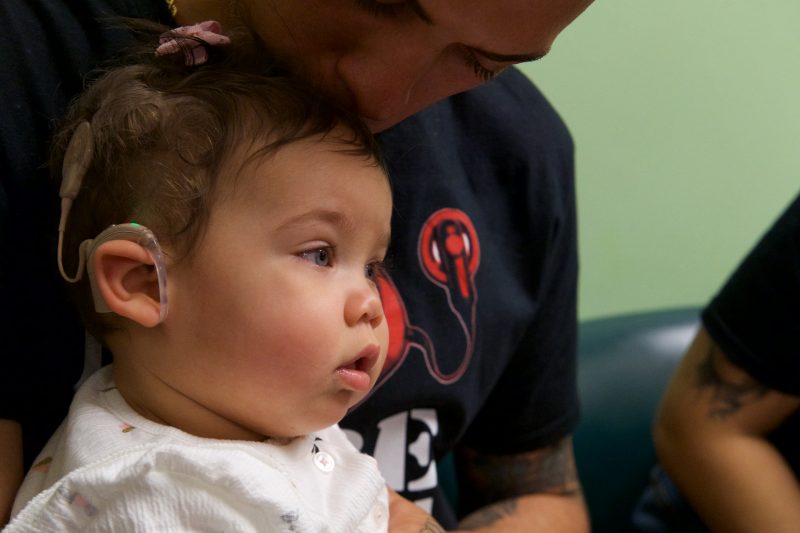
Mia’s family feared she would always be deaf and never hear the sound of their voices.
Mia’s journey to stop the silence
Mia failed her newborn hearing screening soon after birth at St. Joseph Warren Hospital. Doctors weren’t concerned, however, because it can be a normal result due to fluid left in the middle ear after birth or movement, crying during the test.
As time went on, however, it became apparent something was seriously wrong. Mia didn’t turn to look at her parents when they spoke to her, and they struggled to comfort her. Without the ability to soothe Mia with her voice, Leeomara had to constantly hold and rock her, which made nighttime a nightmare.
After several more hearing tests, Mia was diagnosed with a profound hearing loss at 4 months old. That’s when the family was referred to Dr. Jeyakumar.
“We didn’t know anything was wrong with her during my pregnancy,” said Leeomara. “We were very upset and frustrated because we feared Mia would always be deaf and never hear the sound of our voices.”
Dr. Jeyakumar started Mia on hearing aids. They did improve her hearing, but not enough for speech development. The next step was cochlear implants — an electronic medical device surgically implanted that replaces the function of a damaged inner ear, or cochlea, to provide sound signals to the brain.
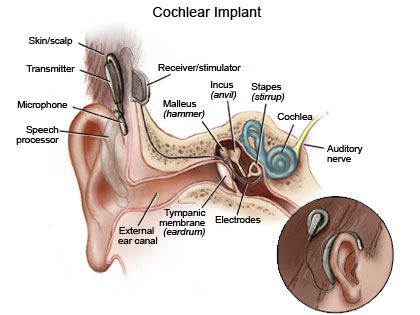
By completely bypassing the damaged part of the cochlea, the cochlear implant uses its own electrical signals to stimulate the auditory nerve, allowing the person to hear. Read more about how the cochlear implant works. Image source: Kidshealth
“It was a struggle at first because we didn’t want Mia to undergo surgery,” said Leeomara. “But after Dr. Jeyakumar sat down with us and explained the entire process and how it works, it calmed our fears. We knew then it was the best thing for Mia, and there was hope that she wouldn’t always be deaf.”
Seeing scary pictures on the internet, the parents also worried about a large scar and its emotional and social repercussions. Dr. Jeyakumar assured the family it was a tiny incision that shouldn’t affect Mia later in life.
Once the family was at ease with the surgery and ready to move forward, they hit another obstacle. The U.S. Food and Drug Administration has set the limit on cochlear implants to 12 months of age, which many insurance companies follow. Therefore, the surgery wasn’t covered. Mia was only a few months shy, but the longer she went without sound, the more behind in language she’d become.
Dr. Jeyakumar took matters into her own hands and successfully convinced the family’s insurance company to approve Mia’s surgery prior to her 12-month birthday.
“I explained to the insurance company that Mia was already wearing hearing aids, but does not respond to sound at all,” said Dr. Jeyakumar. “Giving Mia access to sound now would give her a more even playing field with her hearing peers. Because receptive language (the ability to understand language) starts at about 6 months of age, Mia was already behind in language.”
In late March, Mia underwent cochlear implant surgery — the youngest patient at Akron Children’s to have this procedure. Mia and her young parents from Puerto Rico can now look forward to a future full of sounds.
Mia has begun speech therapy by telemedicine to learn basics, such as what sounds everyday objects make, her name, colors and more. With continued therapy and rehabilitation, Dr. Jeyakumar sees no reason why Mia won’t grow up to be like any of her normal hearing peers.
“We’re so excited and happy,” said Leeomara. “She can finally hear us talking, singing and reading books to her. I’m looking forward to her first birthday (June 23) because Mia will get to hear all of us singing happy birthday to her.”











